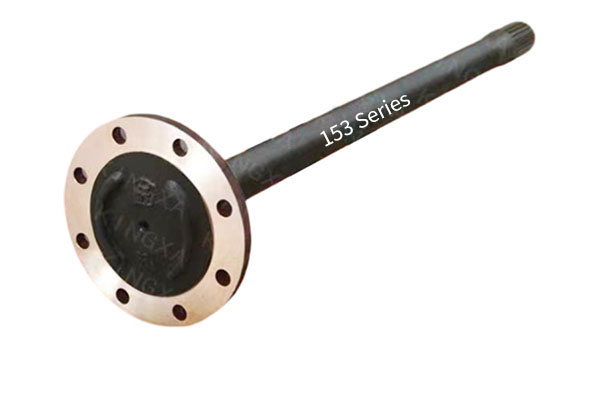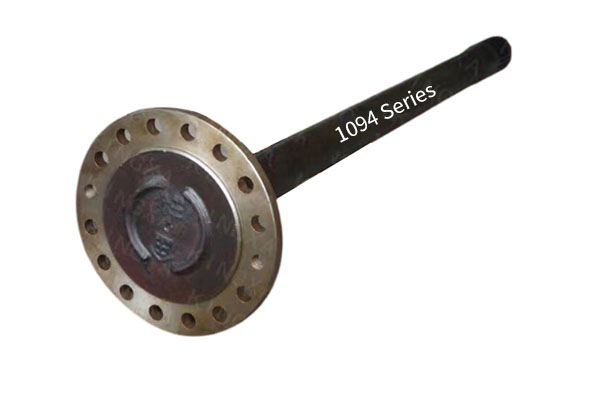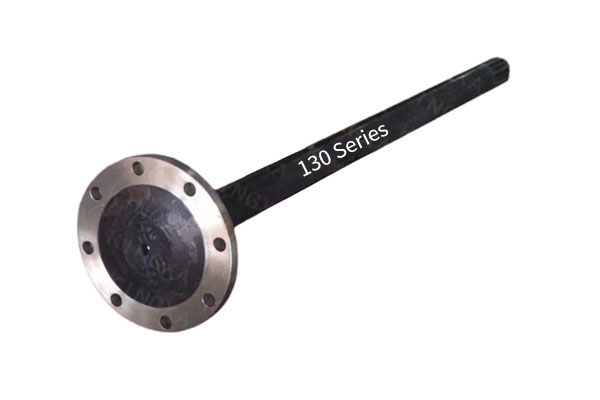How is the mid-size car rear axle half shaft connected to the differential and wheel hub?
Release Time : 2024-12-12
As a key component of power transmission, the mid-size car rear axle half shaft has a delicate and complex connection with the differential and wheel hub, which is related to the vehicle's driving performance and safety.
The connection between the mid-size car rear axle half shaft and the differential is the starting link of power output. The most common method is to use a spline connection, with a high-precision external spline machined on one end of the half shaft, which fits tightly with the internal spline of the differential half shaft gear. The spline design is extremely critical, and its number of teeth, module, and tooth shape are precisely calculated to ensure that the tooth surface contacts evenly and the force is stable when transmitting high torque. For example, the involute spline is favored for its good load-bearing capacity and self-centering characteristics, which can effectively prevent the half shaft from axial movement or circumferential slippage under high-speed rotation and frequent gear shifting impact, ensuring that the power is continuously and accurately transmitted from the differential to the half shaft with minimal error.
The connection part is also equipped with a high-strength locking device, such as a nut or a snap ring. The tightening torque of the nut is strictly controlled, and the force is applied by a precise torque wrench to make the half shaft tightly against the differential half shaft gear to prevent loosening due to vibration and other factors during operation; the snap ring is embedded in a specific slot to additionally "lock" the connection, further enhancing the reliability of the connection. Even if the vehicle experiences bumpy road conditions or sudden acceleration or braking, the connection remains stable.
The connection between the half shaft and the wheel hub is equally important. A common method is to tighten it with bolts. The end of the half shaft is designed as a flange structure with multiple bolt holes evenly distributed, which are precisely connected to the corresponding positions of the wheel hub. High-strength bolts are passed through in turn and tightened according to the specified torque. The bolts are mostly made of alloy steel, which has excellent shear and tensile resistance, enough to withstand the huge force transmitted to the wheel hub by the half shaft when the vehicle is driving. When the vehicle turns or climbs, the half shaft torque makes the wheel hub rotate flexibly, and the bolts firmly maintain the relationship between the two to eliminate the risk of separation.
Some models will also add locating pins on the connection surface to assist in precise positioning during assembly, ensure the coaxiality of the mid-size car rear axle half shaft and the wheel hub, reduce unbalanced vibration during high-speed rotation, optimize vehicle driving smoothness, and ensure that the rear axle power transmission of mid-size cars is smooth and efficient under various working conditions, and the wheels rotate stably, laying a solid foundation for driving comfort and handling stability.
The connection between the mid-size car rear axle half shaft and the differential is the starting link of power output. The most common method is to use a spline connection, with a high-precision external spline machined on one end of the half shaft, which fits tightly with the internal spline of the differential half shaft gear. The spline design is extremely critical, and its number of teeth, module, and tooth shape are precisely calculated to ensure that the tooth surface contacts evenly and the force is stable when transmitting high torque. For example, the involute spline is favored for its good load-bearing capacity and self-centering characteristics, which can effectively prevent the half shaft from axial movement or circumferential slippage under high-speed rotation and frequent gear shifting impact, ensuring that the power is continuously and accurately transmitted from the differential to the half shaft with minimal error.
The connection part is also equipped with a high-strength locking device, such as a nut or a snap ring. The tightening torque of the nut is strictly controlled, and the force is applied by a precise torque wrench to make the half shaft tightly against the differential half shaft gear to prevent loosening due to vibration and other factors during operation; the snap ring is embedded in a specific slot to additionally "lock" the connection, further enhancing the reliability of the connection. Even if the vehicle experiences bumpy road conditions or sudden acceleration or braking, the connection remains stable.
The connection between the half shaft and the wheel hub is equally important. A common method is to tighten it with bolts. The end of the half shaft is designed as a flange structure with multiple bolt holes evenly distributed, which are precisely connected to the corresponding positions of the wheel hub. High-strength bolts are passed through in turn and tightened according to the specified torque. The bolts are mostly made of alloy steel, which has excellent shear and tensile resistance, enough to withstand the huge force transmitted to the wheel hub by the half shaft when the vehicle is driving. When the vehicle turns or climbs, the half shaft torque makes the wheel hub rotate flexibly, and the bolts firmly maintain the relationship between the two to eliminate the risk of separation.
Some models will also add locating pins on the connection surface to assist in precise positioning during assembly, ensure the coaxiality of the mid-size car rear axle half shaft and the wheel hub, reduce unbalanced vibration during high-speed rotation, optimize vehicle driving smoothness, and ensure that the rear axle power transmission of mid-size cars is smooth and efficient under various working conditions, and the wheels rotate stably, laying a solid foundation for driving comfort and handling stability.







